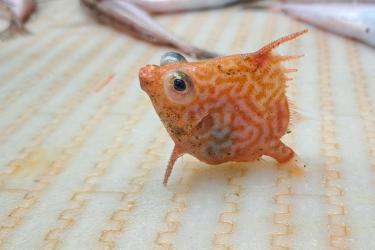In the 1990s, the North Atlantic swordfish population was in trouble—at only 58 percent of its target level, it was considered overfished. But things have changed remarkably, thanks to a 1999 international plan that rebuilt this stock several years ahead of schedule. Today, North Atlantic swordfish is one of the most sustainable seafood choices. How is this possible? The answer points to one of the greatest success stories of United States and international fisheries management.
Under an international rebuilding plan adopted by the International Commission for the Conservation of Atlantic Tunas, the United States reduced landings of North Atlantic swordfish and closed certain fishing grounds to protect undersized swordfish and allow the population to grow and rebuild. U.S. fishermen, managers, and scientists also worked together to develop new management measures that reduce the fishery’s impact on sea turtles and marine mammals.
So has North Atlantic swordfish really rebounded? The answer is absolutely yes. This stock is fully rebuilt, and consumers can rest assured that when they buy North Atlantic swordfish harvested by U.S. vessels, they are supporting one of the most environmentally responsible pelagic longline fisheries in the world.
Learn more about the status of North Atlantic swordfish in the United States
With the stock at a healthy level, NOAA Fisheries is working to further expand opportunities for harvesting North Atlantic swordfish. Rick Pearson, NOAA Fisheries Management Specialist for Highly Migratory Species, explains how this is being done.
Interview with Rick Pearson, NOAA Fisheries Management Specialist for Highly Migratory Species
What is NOAA doing to increase fishing opportunities for Atlantic swordfish?
Since 2007, we have modified the regulations in many ways for commercial and recreational swordfishing, and for other fisheries which inadvertently capture swordfish as bycatch. Catch rates have slowly and steadily increased as a result, but there is still a significant gap between the U.S. catch and the U.S. quota. NOAA is considering a new commercial swordfish hand gear permit. At this stage, NOAA is preparing a proposed rule, which will lay out potential alternatives for a new commercial permit and request public comment. NOAA has also authorized alternative gear types—such as buoy gear—to take advantage of local availability in areas such as the east coast of Florida.
Why is hand gear being considered?
The types of hand gear being considered are tended (fisherman actively watches for a bite), highly selective, and minimize the risk of harming undersized swordfish, non-target species like bluefin tuna, and protected species like sea turtles and marine mammals. This would allow U.S. fishermen to catch more of our quota and profit from the resource, without exceeding the total allowable catch or harming non-target species. Hand gear for swordfish is primarily rod and reel, but also includes handline, harpoon gear, and bandit gear.
How will commercial and recreational fishermen be affected if a new permit is created?
Right now, all commercial permits issued to catch and sell swordfish are limited access, which means no new permits are being issued. Because there are a finite number of these permits, they have become difficult to obtain, and quite expensive. So, there are swordfish available to catch, and plenty of people who want to do it, but there are high barriers to entry into the fishery. Creating a new hand gear permit could open up access to more commercial fishermen. This would likely increase the amount of domestic swordfish in the U.S. market, making a sustainable and delicious option more available to American consumers.
How and when can people comment on this? What kinds of comments are most useful?
The proposed rule and draft Environmental Assessment are expected to publish in early winter 2013 in the Federal Register. Public hearings will be held shortly after the proposed rule is published. Comments should focus on the alternatives presented in the draft Environmental Assessment, and are most helpful when they are specific and include supporting rationale. Tell us which alternatives you prefer, and if you have any other suggestions.

